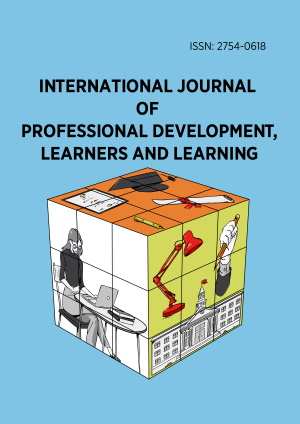Research Article
Development of an Interactive Mobile Application for Learning Undergraduate Educational Technology Concepts
More Detail
1 Department of Educational Technology, Federal University of Technology, Minna, Niger State, NIGERIA2 Puretech Computer Training School, Maitama District II FCT-Abuja, NIGERIA* Corresponding Author
International Journal of Professional Development, Learners and Learning, 4(1), January 2022, ep2204, https://doi.org/10.30935/ijpdll/12009
Submitted: 14 February 2022, Published: 14 April 2022
OPEN ACCESS 3183 Views 3550 Downloads
ABSTRACT
Today’s schooling which is characterized by over-population, insufficient learning resources and incessant closure due to civic crises and pandemic demands more efficient learning models that allow the deployment of technology for students’ active participation in their education. Hence, this study was conducted to develop an interactive mobile application for learning undergraduate educational technology concepts in Nigeria. The ADDIE instructional design model was adopted, and 15 well-structured topics with interactive learning contents and elements were embedded in the developed application built using JavaScript, Html, CSS, Cordova, Articulate 360, Moodle platform, and PHP programming language. The validation of the application was done in three stages and experts involved in the development and validation included educational technology specialists and computer programmers. The mobile application was tested on 30-randomly selected year three undergraduate educational technology students. Findings revealed that exposure to the application improved students’ academic achievement (mean gain=27.87), and there was significant difference (df=28, t=19.97, p<0.05) between the academic achievement score of students at pre- and post-test in favor of the later. The application is therefore considered suitable for teaching and learning of undergraduate educational technology concepts.
CITATION (APA)
Falode, O. C., Dome, K., Chukwuemeka, E. J., & Falode, M. E. (2022). Development of an Interactive Mobile Application for Learning Undergraduate Educational Technology Concepts. International Journal of Professional Development, Learners and Learning, 4(1), ep2204. https://doi.org/10.30935/ijpdll/12009
REFERENCES
- ALFarsi, G., Jabbar J., & ALSinani, M. (2018). Implementing a mobile application news tool for disseminating messages and events of AlBuraimi University College. International Journal of Interactive Mobile Technologies, 12(7), 129-138. https://doi.org/10.3991/ijim.v12i7.9484
- Amasha, M. A., Areed, M. F., Khairy, D., Atawy, S. M., Alkhalaf, S., & Abougalala, R. A. (2021). Development of a Java-based mobile application for mathematics learning. Journal of Education and Information Technologies, 26, 945-964. http://doi:10.1007/s10639-020-10287-0
- Briz-Ponce, L., Pereira, A., Carvalho, L., Juanes-Méndez, J. A., & García-Peñalvo, F. J. (2017). Learning with mobile technologies—students’ behavior. Computers in Human Behavior, 72, 612-620. https://doi.org/10.1016/j.chb.2016.05.027
- Chu, H. C. (2014). Potential negative effects of mobile learning on students’ learning achievement and cognitive load—A format assessment perspective. Journal of Educational Technology & Society, 17(1), 332-344.
- Chukwuemeka, E. J, Babatunde, A. E., Ajani, A. H., & Dominic, S. (2020) A review of instructional models for effective feacher education and technology integration. Sumerianz Journal of Education, Linguistics and Literature, 3(6), 86-95.
- Chukwuemeka, E. J., & Iscioglu, E. (2016). An examination of lecturers’ technological pedagogical content knowledge perceptions at the Faculty of Education in EMU in Cyprus. Croatian Journal of Education: Hrvatski časopis za odgoj i obrazovanje, 18(4), 999-1034 http://cje2.ufzg.hr/ojs/index.php/CJOE/article/viewArticle/1845
- Chukwuemeka, E. J., Dominic, S., Kareem, M. A., & Mailafia, I. A. (2021). Redesigning educational delivery systems: The needs and options for continuous learning during the Coronavirus (COVID-19) pandemic in Nigeria. Contemporary Educational Technology. 13(1), ep292. https://doi.org/10.30935/cedtech/9363
- Cisco. (2020). Annual internet report (2018-2023). https://www.cisco.com/c/en/us/solutions/collateral/executive-perspectives/annual-internet-report/white-paper-c11-741490.html
- Criollo, S., Guerrero-Arias, A., Jaramillo-Alcázar, Á., & Luján-Mora, S. (2021). Mobile learning technologies for education: Benefits and pending issues. Applied Sciences, 11(9), 4111. https://doi.org/10.3390/app11094111
- Dey, N. (2020). Concept and scope of educational technology. https://www.egyankosh.ac.in/bitstream/123456789/63862/1/Unit%201.pdf
- Dingli, A., & Seychell, D. (2015). The new digital natives: Cutting the chord. Springer. https://doi.org/10.1007/978-3-662-46590-5
- Gezgin, D. M. (2019). Effect of mobile learning approach on university students’ academic success on database management systems course. International Journal of Distance Education Technologies, 17(1), 15-30. https://doi.org/10.4018/IJDET.2019010102
- Hilao, M. P., & Wichadee, S. (2017). Gender differences in mobile phone usage for language learning, attitude, and performance. The Turkish Online Journal of Distance Education, 8(2), 68-79. https://doi.org/10.17718/tojde.306558
- Januszewski, A., & Molenda, M. (2008). Educational technology: A definition with commentary. Routeledge.
- Ketyi, A. (2015). Practical evaluation of a mobile language learning tool in higher education. In F. Helm, L. Bradley, M. Guarda, & S. Thouësny (Eds), Critical CALL–Proceedings of the 2015 EUROCALL Conference (pp. 306-311). Padova, Italy. https://doi.org/10.14705/rpnet.2015.000350
- Kocakoyun, S., & Bicen, H. (2017). Development and evaluation of educational android application. Cypriot Journal of Educational Sciences, 12(2), 58-68. https://doi.org/0.18844/cjes.v12i2.1938
- Nichols Hess, A. K., & Greer, K. (2016). Designing for engagement: Using the ADDIE model to integrate high-impact practices into an online information literacy course. Communication in Information Literacy, 10(2), 264-282. http://doi.org/10.15760/comminfolit.2016.10.2.27
- Oyelere, S. S., Suhonen, J., Wajiga, G. M., & Sutinen, E. (2017). Design, development, and evaluation of a mobile learning application for computing education. Education and Information Technologies, 23, 467-495. https://doi.org/10.1007/s10639-017-9613-2
- Wan Daud, W. A. A. b., Wong, K. T., Ghani, M. T. A., & Ramli, S. B. (2021). Gender differences in learning Arabic language proficiency via m-learning among Malaysia university students. Journal of Language and Linguistic Studies, 17(2), 1069-1082. https://doi.org/10.17263/jlls.904123

 The articles published in this journal are licensed under the CC-BY Creative Commons Attribution International License.
The articles published in this journal are licensed under the CC-BY Creative Commons Attribution International License.